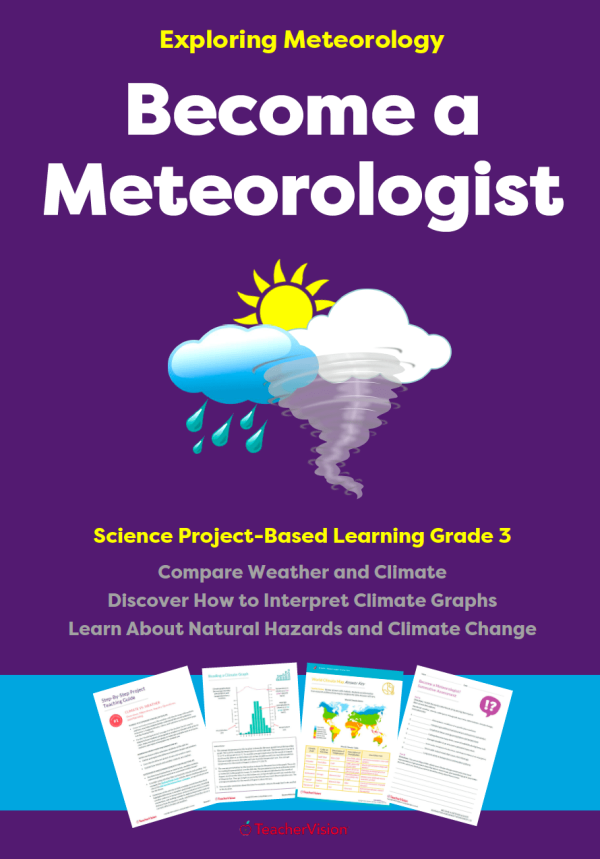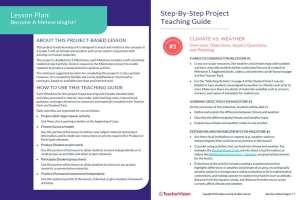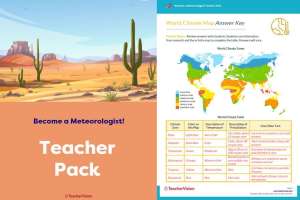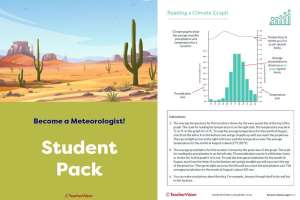
Your Students Learn Hands-On About the Science of Weather and Climate in this NGSS-Aligned, Inquiry-Based PBL Unit!
Your class will become weather forecasters and climate specialists with this engaging PBL on the science of weather and climate. They will develop an understanding of how climate affects weather, how different parts of the world experience weather events, how weather observations are made, how weather contributes to natural disasters, and how to forecast the weather as a meteorologist!
This PBL unit for 3rd grade science will reinforce what your students are learning about climate, weather, and natural disasters by enabling them to become "meteorologists." Along the way, they'll use map, math, writing, and research and skills - while also building collaboration, communication, and problem-solving skills.
What’s Inside
Packed with fun, hands-on activities, extension and enhancement ideas, opportunities for independent and group work, and engaging inquiry-based challenges, this 55-page project-based unit comes complete with:
- For the Teacher: Engaging math lessons with teacher notes, step-by-step instructions for all activities, assessment guidance, and inquiry questions.
- For Students: A full-color Student Pack complete with all of the printables, slides, photos, and instructions students need for the activities - just print (or share) and teach!
A complete, ready-to-teach Teacher Pack that includes:
- Teacher versions of all the student printables with step-by-step annotations and notes for teaching weather and climate science;
- Formative and summative assessments, answer keys, and a full project rubric;
- Instructions and guidance for the extension activities and project enhancements;
- Materials and resources lists, links to articles, videos, and research, plus additional resources for lecture and presentation.
What's Included
- Lesson Plan - Step-by-Step Project Teaching Guide
- Milestone 1: Climate vs. Weather
- Milestone 2: Where in the World?!
- Milestone 3: What's the Weather?
- Milestone 4: Weather Warning
- Milestone 5: Climate Change
Teacher and Student Resources
- Materials Needed for the Projects in this Unit
- Resources for Become a Meteorologist
- Weather and Climate Discussion Points Teacher Notes
- Weather/Climate Venn Diagram Activity
- Weather/Climate Venn Diagram Activity Answer Key
- Weather and Climate Matching Activity
- Weather and Climate Matching Activity Templates
- Milestone #1 Inquiry Question
- World Climate Map Activity
- World Climate Map Activity Answer Key
- Climate: The Americas Mapping Activity
- Climate: The Americas Mapping Activity Answer Key
- Milestone #2 Inquiry Question
- Climate Graph for Brisbane. Australia
- Reading a Climate Graph Activity
- Climograph Activity
- Sunshine and Rainfall Graph
- Milestone #3 Inquiry Question
- Become a Meteorologist Quick Quiz
- Become a Meteorologist Quick Quiz Answer Key
- Weather Hazard Protection Activity
- Weather Hazard Protection Activity Answer Key
- Gallery Walk Project Review Activity
- Milestone #4 Inquiry Question
- Climate Change Activity
- Climate Change Activity Answer Key
- Writing a Climate Change Letter Capstone Project
- Milestone #5 Inquiry Question
- Become a Meteorologist Summative Assessment
- Become a Meteorologist Summative Assessment Answer Key
- Becoming a Meteorologist Project Rubric



OVERVIEW:
This project-based learning lesson is designed to support and reinforce the concepts in a Grade 3 science unit on weather and climate. It is built around 5 inquiry-based milestones that incorporate cross-curricular hands-on projects, formative and summative assessments, independent and group activities, and extensions.
STUDENT/GROUP OUTPUT:
In the course of this project-based learning unit, students will:
Research and understand the difference between climate and weather;
Study the effects of climate on weather in different regions of the world;
Learn how to measure and graph different types of weather phenomena;
Produce a weather climograph for a chosen region and write a letter advocating for more efforts to reduce climate change
SUGGESTED SUBJECT PREREQUISITES:
Students should have background knowledge of weather, climate, geography, and map skills - instructional materials for providing refreshers and instruction are included in the Teacher Pack.
SEQUENCE AND PACING:
This project-based unit is divided into 5 milestones. The minimum suggested duration for completing this project-based unit is 5 class periods. However, the unit is completely flexible and can be lengthened or shortened as necessary or desired, based on available class time and interest level.
TECHNOLOGY RESOURCES (suggested):
Internet access
STANDARDS ALIGNMENT (NGSS)
MILESTONE #1
• 3-ESS2-2 Obtain and combine information to describe climates in different regions of the world.
• Understand typical weather in different parts of the world and at different times of the year.
MILESTONE #2
• 3-ESS2-2 Obtain and combine information to describe climates in different regions of the world.
• Understand typical weather in different parts of the world and at different times of the year.
MILESTONE #3
• 3-ESS2-1 Represent data in tables and graphical displays to describe typical weather conditions expected during a particular season.
• Organize and use data to describe typical weather conditions expected during a particular season.
MILESTONE #4
• 3-ESS3-1 Make a claim about the merit of a design solution that reduces the impacts of a weather-related hazard.
• Consider the merits or problems of a design solution that reduces the impacts of such hazards.
MILESTONE #5
• 3-ESS3-1 Make a claim about the merit of a design solution that reduces the impacts of a weather-related hazard.
• Consider the merits or problems of a design solution that reduces the impacts of such hazards.






